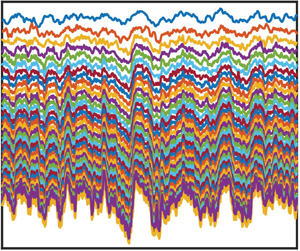Crossref Citations
This article has been cited by the following publications. This list is generated based on data provided by
Crossref.
Wang, Mengze
and
Zaki, Tamer A.
2022.
Synchronization of turbulence in channel flow.
Journal of Fluid Mechanics,
Vol. 943,
Issue. ,
Li, Jian
Tian, Mengdan
and
Li, Yi
2022.
Synchronizing large eddy simulations with direct numerical simulations via data assimilation.
Physics of Fluids,
Vol. 34,
Issue. 6,
Inubushi, Masanobu
Saiki, Yoshitaka
Kobayashi, Miki U.
and
Goto, Susumu
2023.
Characterizing Small-Scale Dynamics of Navier-Stokes Turbulence with Transverse Lyapunov Exponents: A Data Assimilation Approach.
Physical Review Letters,
Vol. 131,
Issue. 25,
Nikolaidis, Marios-Andreas
Ioannou, Petros J.
Farrell, Brian F.
and
Lozano-Durán, Adrián
2023.
POD-based study of turbulent plane Poiseuille flow: comparing structure and dynamics between quasi-linear simulations and DNS.
Journal of Fluid Mechanics,
Vol. 962,
Issue. ,
Nikolaidis, Marios-Andreas
Ioannou, Petros J.
and
Farrell, Brian F.
2024.
Fluctuation covariance-based study of roll-streak dynamics in Poiseuille flow turbulence.
Journal of Fluid Mechanics,
Vol. 988,
Issue. ,
Li, Jian
Tian, Mengdan
Li, Yi
Si, Wenwen
and
Mohammed, Huda Khaleel
2024.
The conditional Lyapunov exponents and synchronisation of rotating turbulent flows.
Journal of Fluid Mechanics,
Vol. 983,
Issue. ,
Kiorpelidis, Ioannis
and
Bakas, Nikolaos A.
2025.
Parametric Instabilities in Time-Varying Compressible Linear Flows.
Fluids,
Vol. 10,
Issue. 1,
p.
18.
Zaki, Tamer A.
2025.
Turbulence from an Observer Perspective.
Annual Review of Fluid Mechanics
,
Vol. 57,
Issue. 1,
p.
311.
Li, Jian
Si, Wenwen
Li, Yi
and
Xu, Peng
2025.
Intrinsic relationship between synchronisation thresholds and Lyapunov vectors: evidence from large eddy simulations and shell models.
Journal of Fluid Mechanics,
Vol. 1008,
Issue. ,

 $\ell _{x c}$, that separates the active from the synchronized passive subspace is identified as the streamwise wavelength at which perturbations to the time-dependent turbulent flow with streamwise wavelengths
$\ell _{x c}$, that separates the active from the synchronized passive subspace is identified as the streamwise wavelength at which perturbations to the time-dependent turbulent flow with streamwise wavelengths  $\ell _x<\ell _{xc}$ have negative characteristic Lyapunov exponents. The critical wavelength is found to be approximately 130 wall units and obeys viscous scaling at these Reynolds numbers.
$\ell _x<\ell _{xc}$ have negative characteristic Lyapunov exponents. The critical wavelength is found to be approximately 130 wall units and obeys viscous scaling at these Reynolds numbers.